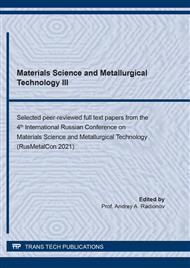[1]
V.K. Grigorovich, Hardness and Microhardness of Metals, Nauka, Moscow, (1976).
Google Scholar
[2]
N.N. Davidenkov, Dynamic Metal Testing, Book on Demand, Moscow, (2020).
Google Scholar
[3]
A.V. Shaparev, I.A. Savin, S.N. Ptichkin, Application of the polymeric material RIMAMID for production of machine, IOP Conf. Series: Materials Science and Engineering. 969 (2020) 012021.
DOI: 10.1088/1757-899x/969/1/012021
Google Scholar
[4]
R.V. Gavariev, I.A. Savin, I.O. Leushin, To the question of casting alloys of non-ferrous metals in the metal mold, Materials Science Forum. 946 (2019) 631-635.
DOI: 10.4028/www.scientific.net/msf.946.631
Google Scholar
[5]
I.P. Balabanov, V.N. Gilman, T.S. Timofeeva, A.I. Faskhutdinov, Modeling of the cutting edge rounding influence on the tool life in processing a gear wheel by the Power Skiving method, International Journal of Engineering and Technology(UAE). 7(4) (2018) 71-73.
DOI: 10.14419/ijet.v7i4.7.20386
Google Scholar
[6]
R.V. Gavariev, K.N. Gavarieva, On the issue of heat balance of molds for injection molding of non-ferrous metal alloys, IOP Conference Series: Materials Science and Engineering. 969(1) (2020) 012069.
DOI: 10.1088/1757-899x/969/1/012069
Google Scholar
[7]
K.N. Gavarieva, L.A. Simonova, D.L. Pankratov, R.V. Gavariev, Development of expert systems for modeling of technological process of pressure casting on the basis of artificial intelligence, IOP Conference Series: Materials Science and Engineering. 240 (2017) 012019.
DOI: 10.1088/1757-899x/240/1/012019
Google Scholar
[8]
A.V. Shaparev, I.A. Savin, Influence of the state of the contact surfaces on the formation of the joint of steel and brass during cold cladding, Solid State Phenomena. 284 (2018) 319-325.
DOI: 10.4028/www.scientific.net/ssp.284.319
Google Scholar
[9]
D.L. Pankratov, R.V. Gavariev, K.N. Gavarieva, Influence of multilayer coatings on the operational stability of molds for injection molding, IOP Conference Series: Materials Science and Engineering. 134 (2016) 012031.
DOI: 10.1088/1757-899x/134/1/012031
Google Scholar
[10]
A.V. Shaparev, I.A. Savin, Calculation of joint plastic deformation to form metal compound in cold condition, Solid State Phenomena. 265 (2017) 313-318.
DOI: 10.4028/www.scientific.net/ssp.265.313
Google Scholar
[11]
V.N. Gilman, A.I. Fashutdinov, I.P. Balabanov, Experience in the application of nitriding in a glow discharge to increase the efficiency of gear processing by the method of grinding, IOP Conference Series: Materials Science and Engineering. 915(1) (2020) 012014.
DOI: 10.1088/1757-899x/915/1/012014
Google Scholar
[12]
A.V. Shaparev, I. Savin, Calculation of the amount of the reduction required for the formation of compound layers during cold rolling of bimetals, Materials Science Forum. 870 (2016) 328-333.
DOI: 10.4028/www.scientific.net/msf.870.328
Google Scholar
[13]
V.N. Gilman, I.P. Balabanov, A.I. Fashutdinov, Improving the efficiency of shaving through the use of wear-resistant coatings, IOP Conference Series: Materials Science and Engineering. 570(1) (2019) 012024.
DOI: 10.1088/1757-899x/570/1/012024
Google Scholar
[14]
R.V. Gavariev, I.A. Savin, E.N. Soldatkina, Choice of protective coating of metal molds for casting non-ferrous alloys, Solid State Phenomena. 299 (2020) 867-871.
DOI: 10.4028/www.scientific.net/ssp.299.867
Google Scholar
[15]
D.L. Pankratov, R.V. Gavariev, Improving the quality of castings made of non-ferrous metal alloys when casting in metal molds, IOP Conference Series: Materials Science and Engineering. 570(1) (2019) 012072.
DOI: 10.1088/1757-899x/570/1/012072
Google Scholar
[16]
R.V. Gavariev, I.A. Savin, K.N. Gavarieva, Determination of properties of wear-resistant coatings of metal forms, Solid State Phenomena. 316 (2021) 732-737.
DOI: 10.4028/www.scientific.net/ssp.316.732
Google Scholar
[17]
V.N. Gilman, A.I. Faskhutdinov, I.P. Balabanov, Increase effectiveness of shaving by using wear-resistant coatings and preliminary modeling cutting, Solid State Phenomena. 299 (2020) 839-844.
DOI: 10.4028/www.scientific.net/ssp.299.839
Google Scholar
[18]
Z. Wang, Q. Fang, J. Li, B. Liu, Y. Liu, Effect of lattice distortion on solid solution strengthening of BCC high-entropy alloys, Journal of Materials Science and Technology. 34(20) (2018) 349-354.
DOI: 10.1016/j.jmst.2017.07.013
Google Scholar
[19]
H. Diao, X. Xie, F. Sun, K.A. Dahmen, P.K. Liaw, Mechanical properties of high-entropy alloys, in: M. Gao, JW. Yeh, P. Liaw, Y. Zhang (eds), High-Entropy Alloys, Springer, Cham, 2016, pp.181-236.
DOI: 10.1007/978-3-319-27013-5_6
Google Scholar
[20]
X. Wang, W. Guo, Y. Fu, High-entropy alloys: Emerging materials for advanced functional applications, Journal of Materials Chemistry A. 9(2) (2021) 663-701.
DOI: 10.1039/d0ta09601f
Google Scholar
[21]
F. Pacheco-Torgal, S. Jalali, Nanotechnology: Advantages and drawbacks in the field of construction and building materials, Construction and Building Materials. 25(2) (2011) 582-590.
DOI: 10.1016/j.conbuildmat.2010.07.009
Google Scholar
[22]
M. Sebastiani, K.E. Johanns, E.G. Herbert, G.M. Pharr, Measurement of fracture toughness by nanoindentation methods: Recent advances and future challenges, Current Opinion in Solid State and Materials Science. 19(6) (2015) 324-333.
DOI: 10.1016/j.cossms.2015.04.003
Google Scholar


